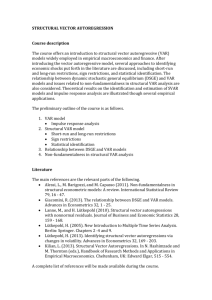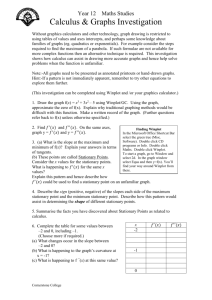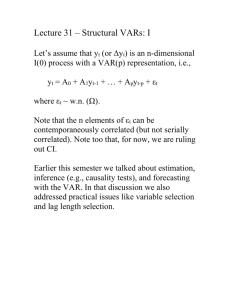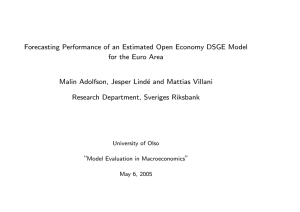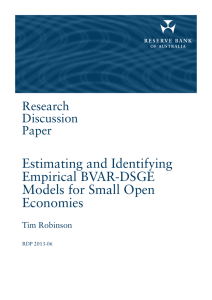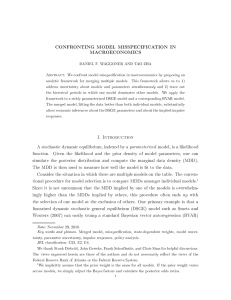Non-Stationary Hours in a DSGE Model
advertisement
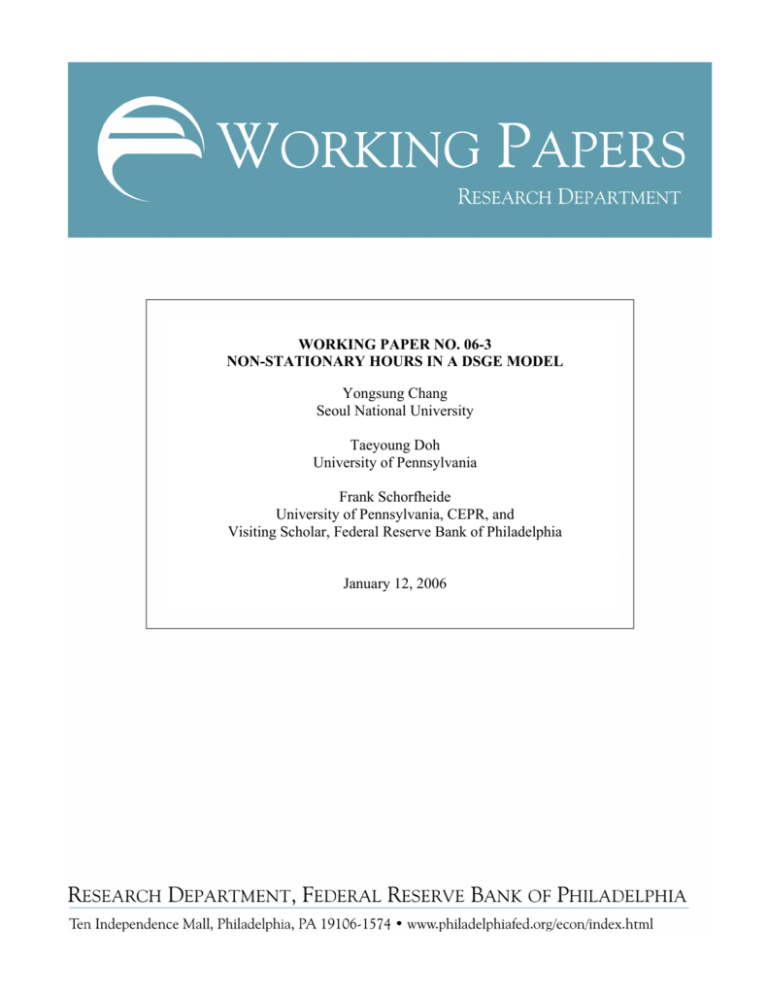
WORKING PAPER NO. 06-3 NON-STATIONARY HOURS IN A DSGE MODEL Yongsung Chang Seoul National University Taeyoung Doh University of Pennsylvania Frank Schorfheide University of Pennsylvania, CEPR, and Visiting Scholar, Federal Reserve Bank of Philadelphia January 12, 2006 Non-stationary Hours in a DSGE Model Yongsung Chang Taeyoung Doh Frank Schorfheide∗ Seoul National University University of Pennsylvania University of Pennsylvania CEPR January 12, 2006 Abstract The time series fit of dynamic stochastic general equilibrium (DSGE) models often suffers from restrictions on the long-run dynamics that are at odds with the data. Relaxing these restrictions can close the gap between DSGE models and vector autoregressions. This paper modifies a simple stochastic growth model by incorporating permanent labor supply shocks that can generate a unit root in hours worked. Using Bayesian methods we estimate two versions of the DSGE model: the standard specification in which hours worked are stationary and the modified version with permanent labor supply shocks. We find that the data support the latter specification. ∗ JEL CLASSIFICATION: C32, E52, F41 KEY WORDS: Bayesian Econometrics, DSGE Models, Non-stationary Hours Yongsung Chang: School of Economics, Shillim-Dong, Kwanak-Gu, Seoul, Korea 151-742; email: Yohg@snu.ac.kr. Taeyoung Doh and Frank Schorfheide: Department of Economics, McNeil Building, 3718 Locust Walk, Philadelphia, PA 19104-6297; email: doht@ssc.upenn.edu and schorf@ssc.upenn.edu. We are thankful to Martin Eichenbaum and Robert Vigfusson, who kindly provided their data. Chang gratefully acknowledges the Research Grant of the School of Economics at Seoul National University. Schorfheide gratefully acknowledges financial support from the Alfred P. Sloan Foundation. GAUSS programs that implement the empirical analysis will be available at www.econ.upenn.edu/˜schorf. The views expressed here are those of the authors and not necessarily reflect the views of the Federal Reserve Bank of Philadelphia or the Federal Reserve System. This paper is available free of charge at www.philadelphiafed.org/econ/wps/index.html. 1 1 Introduction Dynamic stochastic general equilibrium (DSGE) models have become a workhorse for studying various aggregate economic phenomena. Since these models generate both business cycle fluctuations as well as long-run growth paths, they should ultimately be able to match data across all frequencies. Despite the significant progress in developing empirically viable models, e.g., Christiano, Eichenbaum, and Evans (2005) and Smets and Wouters (2003), the time series fit of DSGE models is typically inferior to the fit of vector autoregressions (VAR) that are estimated with well-calibrated shrinkage methods, as documented in Del Negro, Schorfheide, Smets, and Wouters (2004). One reason for the poor time series fit is the restrictions imposed by the so-called balanced growth path. Along the balanced growth path, (i) the “big ratios” (investment-output, consumption-output, capital-output, and real wage-output) are stable as output, consumption, investment, capital stock, and real wages grow at the same rate, and (ii) the real rates of return to capital and per capita hours worked are stationary.1 As pointed out, for instance, by Canova, Finn, and Pagan (1994), these model-implied co-trending relationships are often rejected by the data. Modifications to the probabilistic structure of the exogenous shocks that generate fluctuations in DSGE models can be used to generalize trend structures. For instance, in a two-sector model Edge, Laubach, and Williams (2003) introduce trends in sector-specific productivity processes such that the relative price of investment becomes non-stationary and real investment and consumption can grow at different rates. This paper focuses on the stationarity of hours worked. Many researchers doubt that hours worked are stationary as we have observed apparent changes in labor-supply patterns over recent decades, e.g., McGrattan and Rogerson (2004), and Galı́ (2005). Usual suspects responsible for persistent shifts in per capita hours are structural changes in demography, government purchases, tax codes, household production technology, or preferences itself. Recently, business cycle theorists have been particularly concerned with this issue because assumptions about the persistence of hours has far reaching implications for our understanding of propagation mechanisms as well as the sources of economic fluctuations. Shapiro and Watson (1988) report that about half of the cyclical variation in output can be accounted for by the stochastic trend in labor supply. In response to a 1 See King, Plosser, and Rebelo (1988) for the restrictions on technology and preferences that satisfy the balanced growth path property. 2 provocative finding by Galı́ (1999) that hours worked decrease after a favorable technology shock, Christiano, Eichenbaum, and Vigfusson (2003), henceforth CEV, Chari, Kehoe, and McGrattan (2004), and Basu, Fernald, and Kimball (2004) show that the statistical inference in a structural VAR crucially depends on the treatment of low frequency components of hours worked. This paper makes two contributions. First, we present a modified stochastic growth model in which hours worked have a stochastic trend, generated by a non-stationary labor supply shock. In terms of properly detrended variables the model has a well-defined steady-state and can be solved, for instance, by a log-linear approximation around this steady state. Since this specification implies that the technology shock is the only source for permanent shifts in average labor productivity, the popular long-run VAR identification scheme for technology shocks remains consistent with our model. The modification proposed in this paper can be easily incorporated into large-scale DSGE models with real and nominal rigidities and potentially improve their empirical performance. Second, based on output and hours data we compute posterior odds for two stochastic growth models: one with stationary hours and the other with non-stationary hours. We find for three alternative data sets that the model with a non-stationary labor supply shock is preferred. Posterior probabilities range from 93.1 to 99.4%.2 However, as the prior distribution for the autocorrelation of the labor supply shock in the model with stationary hours is shifted toward more persistence, the evidence in favor of the non-stationary hours specification decreases. This finding is a reflection of the well-known fact that it is difficult to distinguish unit-root from highly persistent yet stationary dynamics. Given the weak and partially conflicting evidence on the stationarity of hours from univariate tests as, for instance, documented by CEV, it is in our view preferable to conduct a multivariate specification analysis directly in the context of the model of interest. Cross-coefficient restrictions and the careful specification of prior distributions can help to sharpen inference. This view is mirrored in CEV’s VAR analysis, in which they advocate a multivariate encompassing test over univariate unit-root tests. Unfortunately, CEV dodge the delicate issue of specifying prior distributions for their model parameters by the construction of pseudo-posterior odds ratios that ignore the likelihood functions of their VARs. While CEV find no gains from imposing difference stationarity of hours in their VAR, our analysis documents that the unit-root specification improves the DSGE model. 2 All statements in this paper involving posterior odds or posterior model probabilities assume that the specifica- tions have equal prior probability. 3 The remainder of this paper is organized as follows. Section 2 presents the stochastic growth model and discusses its long-run dynamics. Section 3 explains our estimation procedure. The results from the empirical analysis are presented in Section 4 and Section 5 concludes. 2 Model The model economy is a one-sector stochastic growth model with technology and labor supply shocks. We consider two versions of the model that differ only with respect to the persistence of the labor supply shock. The representative household maximizes the expected discounted lifetime utility from consumption Ct and hours worked Ht : E0 "∞ X t=0 Ã β t (Ht /Bt )1+1/ν ln Ct − 1 + 1/ν !# . (1) The log utility in consumption implies a constant long-run labor supply in response to a permanent change in technology. The short-run (Frisch) labor supply elasticity is ν. The labor supply shock is denoted by Bt . An increase of Bt raises the labor supply. This may reflect permanent shifts in per capita hours of work due to demographic changes, tax reforms, shifts in the marginal rate of substitution between leisure and consumption, or (non-neutral) technological changes in household production technology. The household supplies labor at the competitive equilibrium wage Wt and rents capital Kt to the firms at the competitive rental rate Rt . The capital stock depreciates at the rate δ, and the per-period budget constraint faced by the household is Ct + Kt+1 − (1 − δ)Kt = Wt Ht + Rt Kt . (2) Firms rent capital, hire labor services, and produce final goods according to the following Cobb-Douglas technology: Yt = (At Ht )α Kt1−α . (3) The stochastic process At captures the exogenous labor augmenting technical progress. Profit maximization of the firm and factor market equilibrium conditions determine wage and rental rate: Wt = αAαt Htα−1 Kt1−α , Rt = (1 − α)(At Ht )α Kt−α . (4) 4 We assume that the log production technology evolves according to a random walk with drift: ²a,t ∼ iidN (0, σa2 ). ln At = γ + ln At−1 + ²a,t , (5) The level of technology in period t = 0 is denoted by A0 . We consider two specifications for the labor supply process Bt . Under specification M0 the labor supply shock follows a stationary AR(1) process: M0 : ln Bt = ρb ln Bt−1 + (1 − ρb ) ln B0 + ²b,t , ²b,t ∼ iidN (0, σb2 ), (6) where 0 ≤ ρb < 1 and ln B0 is the unconditional mean of ln Bt . In model M0 the innovation ²b,t only has a transitory effect. Alternatively, under specification M1 the labor supply shock evolves according to a random walk: M1 : ln Bt = ln Bt−1 + ²b,t , ²b,t ∼ iidN (0, σb2 ) (7) and we use B0 to denote the initial level of Bt . In both specifications, the innovations ²a,t and ²b,t are assumed to be uncorrelated at all leads and lags. It is well known that in model M0 hours are stationary and that output, consumption, and capital grow according to the technology process At . Hence, one can induce stationarity with the following transformation: M0 : Yt , Yet = At et = Ct , C At e t+1 = Kt+1 . K At In model M1 , on the other hand, the labor supply shock Bt induces a stochastic trend into hours as well as output, consumption, and capital. To obtain a stationary equilibrium these variables have to be detrended according to: M1 : e t = Ht , H Bt Yet = Yt , At Bt et = Ct , C At Bt e t+1 = Kt+1 . K At Bt With these transformations, we obtain a system of rational expectations equations that characterizes the equilibrium dynamics of the endogenous variables in the neighborhood of the steady state. It can be solved by standard log-linearization methods, e.g., King, Plosser, and Rebelo (1988), or Sims (2002). We note two important aspects of the model specification. First, while in M1 a positive labor supply shock raises both hours worked and output permanently, one can show that it does not have 5 a permanent effect on labor productivity Yt /Ht . Thus, both M0 and M1 are consistent with the following popular identification assumption: technology shocks are the only source for a stochastic trend in labor productivity. Second, under specification M1 there is a positive probability that hours worked exceed a given threshold H̄, e.g., 24 hours per day. Our log-linear approximation of M1 ignores this bound and provides an accurate characterization of the local dynamics only if hours worked are well below this threshold. Empirically, we think that this is the case and the non-stationary version of the stochastic growth model may provide a better fit. A similar issue arises when modelling nominal interest rates, which often appear to be locally non-stationary but at the same time are bounded from below by zero. While linear time series models cannot explain apparent unit root behavior of interest rates between, say 4% and 12%, and mean-reverting behavior elsewhere, nonlinear models can. For instance, Aı̈t-Sahalia (1996) estimates a diffusion model with a nonlinear drift function that is consistent with interest rates appearing to be non-stationary processes over extended time periods while being overall stationary. 3 Econometric Approach We will fit M0 and M1 to observations on the log level of real per capita output and hours worked, denoted by the 2 × 1 vector yt . Let ²t = [²a,t , ²b,t ]0 and define the vector of structural model parameters as θ = [α, β, γ, δ, ν, ln A0 , ln B0 , ρb , σa , σb ]0 . It is well known that log-linearized DSGE models have a state space representation, which we will express as follows: yt = Γ0 + Γ1 s1,t + Γ2 s2,t + Γ3 t s1,t = Φ1 s1,t−1 + Ψ1 ²t s2,t = s2,t−1 + Ψ2 ²t . (8) (9) (10) The system matrices of this state space representations are functions of the structural parameters θ. The trend in (8) captures the effect of the drift in the random walk technology process At . Equation (9) represents the law of motion for the state variables of the detrended model, and (10) describes the evolution of s2,t = ln At − γt for M0 and s2,t = [ln At − γt, ln Bt ]0 for specification M1 . 6 The Kalman filter can be used to compute the likelihood function L(θ|Y T ) for the state space system (8) - (10). To initialize the Kalman filter a distribution for the state vector in period t = 0 has to be specified. If all the state variables are stationary then a natural choice for the initialization is the unconditional distribution of st . However, in our model part of the state vector, s2,t , is nonstationary. Hence, we factorize the initial distribution as p(s1,0 )p(s2,0 ) and set the first component equal to the unconditional distribution of s1,t , whereas the second component, composed of the distribution of ln A0 (M0 ) and [ln A0 , ln B0 ]0 (M1 ), respectively, is absorbed into the specification of our prior p(θ). According to Bayes Theorem the posterior distribution of θ is given by p(θ|Y T ) = L(θ|Y T )p(θ)/p(Y T ). The fit of models M0 and M1 can be assessed based on the marginal data densities Z T p(Y |Mi ) = L(θ|Y T , Mi )p(θ|Mi )dθ, i = 1, 2. (11) (12) If the prior odds of two models are equal to one, then the ratio of marginal data densities provides the posterior odds. Log marginal data densities penalize the maximized log likelihood function by a measure of model complexity and can be interpreted as a measure of one-step-ahead out-of-sample predictive performance. The Bayesian analysis is implemented with Markov Chain Monte Carlo methods described in Schorfheide (2000). 4 Empirical Analysis We use three different data sets comprised of quarterly U.S. real per capita GDP and hours worked from 1954:Q2 to 2001:Q4. The observations from 1954:Q2 to 1958:Q4 are treated as pre-sample to quantify prior distributions. Since we are comparing the fit of the DSGE model specifications to that of a VAR with 4 lags, we reserve the observations from 1959:Q1 to 1959:Q4 for the initialization of lags. Since the VAR likelihood function is conditional on the 1959 observations, we adjust the DSGE model likelihood function accordingly.3 For Data Set 1 we use real GDP from the DRIGlobal Insight database (GDPQ) and divide it by population of age 20 or older (PM20+PF20). Hours worked is measured as average weekly hours of all people in the non-farm business sector 3 This adjustment can be easily implemented by calculating L(θ|y−3 , . . . , y0 , Y T )/L(θ|y−3 , . . . , y0 ), where y0 cor- responds to 1959:Q4 and Y T denotes to sample 1960:Q1 to 2001:Q4. 7 compiled by the Bureau of Labor Statistics (EEU00500005). We multiply the hours series by the employment ratio, which is the number of people employed (LHEM, DRI-Global Insight) divided by population (PM20+PF20). Data Set 2 is obtained from CEV. Per capita output is obtained by dividing GDPQ by civilian population age 16 or older (P16, DRI-Global Insight). Hours worked are measured as total hours (LBMN, DRI-Global Insight) divided by P16. Data Set 3 has been used by Galı́ and Rabanal (2004) and is extracted from Haver Analytics’ USECON database. Output is defined as nonfarm business sector output (LXNFO) divided by civilian noninstitutional population age 16 or older (LNN). Hours are measured as nonfarm business sector hours (LXNFH) divided by the same population measure. All series are seasonally adjusted4 and transformed by taking natural logs. The observations are depicted in Figure 1. Log output is plotted relative to 1982:Q1 and the three log hours series are demeaned by their respective sample averages. An informal inspection of the plots suggests that hours worked are highly persistent in all three data sets. Hence, specification M1 may provide an empirically plausible alternative to M0 . The benchmark prior distribution of the parameters is summarized in Table 1. We assume all parameters to be a priori independent. By and large, the prior means are chosen based on a pre-sample of observations from 1954:Q2 to 1958:Q4. The prior mean of the labor share α is 0.66 and that for the quarter-to-quarter growth rate of productivity, γ, is 0.5%. The prior for β is centered at 0.995. Combined with the prior mean of γ, this corresponds to an annualized real return of about 4%. The depreciation rate δ lies between 1.8% and 3.3% per quarter. The 90% probability interval for the Frisch labor supply elasticity ν ranges from 0.3 to 1.8. For the stationary hours model M0 the prior mean of ln B0 is constructed by matching average e ∗ , evaluated hours worked over the pre-sample period with the steady state level of hours worked H at the prior mean values of the remaining structural parameters. For M1 the prior mean of ln B0 e ∗ . Similarly, we is obtained by equating hours worked in 1958:Q4 with the steady state level B0 H select the prior mean of ln A0 by matching A0 Ye ∗ and A0 B0 Ye ∗ , respectively, with the level of output in 1958:Q4. The prior standard deviations for ln A0 and ln B0 are 0.2. Finally, for specification M0 the 90% confidence interval for the autoregressive parameter ρb ranges from 0.835 to 0.982, implying a fairly persistent labor supply process. 4 We use the X-12 filter to adjust the BLS hours series EEU0050005. 8 The posterior means and 90% probability intervals are reported in Table 2. For convenience, we also report probability intervals for the prior distribution. The estimates of α, β, δ, and γ are very similar across data sets and model specifications. While the data are not very informative about α, β, and δ the probability interval of γ shrinks by a factor of 4. The posterior means of the labor supply elasticity ν range from 0.4 to 1 and are somewhat larger than the micro-level estimates. However, our estimates are roughly consistent with the estimates obtained by Chang and Kim (2005) and estimates from an experimental survey by Kimball and Shapiro (2003), who report a value of about 1. The estimated standard deviations of the structural shocks are similar across data sets and model specifications. For the stationary model, we observe that the estimated autocorrelation of the labor supply shocks is near unity, exceeding 0.95 in all three data sets. To assess overall time series fit of the stochastic growth models, we report marginal data densities in Table 4. For all three data sets, the non-stationary model has a higher marginal data density than the stationary model. The posterior odds in favor of M1 range from 14:1 (Data Set 1) to 156:1 (Data Set 2). In addition to the DSGE models we estimate a VAR in log levels of output and hours yt = Φ0 + Φ1 yt−1 + . . . + Φp yt−p + ut , ut ∼ iidN (0, Σ) (13) with p = 4 lags using a Minnesota prior.5 This prior shrinks the VAR estimates toward univariate random walk representations. While the VAR dominates both M0 and M1 in terms of the marginal data density, the generalization of the balanced growth structure due to a non-stationary preference shock improves the fit of the DSGE model and narrows the gap between DSGE model and VAR. For instance, based on Data Set 2 the odds of VAR versus M0 are only 7:1. We conduct a number of robustness checks by re-estimating M0 and M1 under alternative prior distributions presented in Table 3. Prior A1 uses a more diffuse distribution for ln B0 in the non-stationary model M1 , whereas the distribution under A2 is more concentrated than for the benchmark prior. Not surprisingly, the marginal data density deteriorates under the less informative Prior A1 for all three data sets. However, the change is small because our analysis is conditioned on 5 See Doan, Litterman, and Sims (1984). Our version is implemented via dummy observations based on MATLAB code provided by Chris Sims. A description can be found in Appendix C of Lubik and Schorfheide (2005). We use the following hyperparameters: d = 0.5, λ = 5, µ = 2, τ = 3. Mean and standard observations of yt are calculated based on the pre-sample. 9 four initial observations. Tightening the prior for ln B0 leaves the marginal data density virtually unchanged. Priors A3 and A4 modify the distribution of ρb in M0 by increasing (A3) and decreasing (A4) the implied persistence of the labor supply shock. For all three data sets A3 raises the marginal data density of M0 and hence narrows the gap between M0 and M1 . For instance, based on Data Set 1 the odds in favor of the non-stationary specification drop from 14:1 to 5:1. If one compares M0 with Prior A3 to M1 with Prior A1, then the two specifications attain roughly equal posterior probabilities. Under Prior A4, on the other hand, the marginal data density of M0 falls relative to the benchmark prior. While overall the non-stationary specification M1 is the preferred one, the particular margin is sensitive to the prior, reflecting the difficulty of distinguishing unit root from stationary yet highly persistent dynamics in finite samples. Posterior mean impulse responses of output, hours, and labor productivity to technology and labor supply shocks are depicted in Figure 2. The estimated impulse response functions for Data Set 2 and 3 are similar to those obtained from Data Set 1 and hence omitted. Given the simple structure of the model and its well-known lack of internal propagation, the impulse responses are monotonic. A technology shock raises output permanently. Hours worked increase initially and then return to the steady state level. Under M0 a preference shock increases labor supply and raises output and hours worked temporarily, whereas under M1 the increase is permanent. However, the labor supply shock does not affect labor productivity permanently so that the technology shock remains the unique source of permanent shifts in labor productivity. 5 Conclusion Since DSGE models generate both business cycle fluctuations as well as long-run growth paths they should ultimately be able to match the data across all frequencies to be quantitatively taken seriously. However, the time series fit of DSGE models often suffers from restrictions on the longrun dynamics that are at odds with the data. This paper considered a stochastic growth model in which the marginal rate of substitution between leisure and market consumption changes over time. If this exogenous shock to labor supply has a unit root, hours worked become non-stationary. According to our empirical analysis, the version of the model in which labor supply shifts have a 10 permanent component attains a better time series fit and narrows the gap between DSGE model and VAR. Our modification can be easily incorporated into more sophisticated DSGE models with real and nominal frictions. While this paper has focused on improving time series fit by modifying an exogenous process, the ultimate goal should be to improve the structure of the labor market specification to reduce the role of exogenous shocks by unveiling economic factors behind persistent movements in hours. References Aı̈t-Sahalia, Y. (1996): “Testing Continuous-Time Models of the Spot Interest Rate,” Review of Financial Studies, 9, 385-426. Basu, S., J. Fernald, and M. Kimball (2004): “Are Technology Improvements Contractionary?” Federal Reserve Bank of Chicago Working Paper, 2004-20. Canova, F., M. Finn, and A. Pagan (1994): “Evaluating a Real Business Cycle Model,” in: C. Hargreaves (ed.) “Non-stationary Time Series Analysis and Cointegration,” Oxford University Press. Chang, Y. and S. Kim (2005): “From Individual to Aggregate Labor Supply: A Quantitative Analysis Based on Heterogeneous Agent Macroeconomy,”International Economic Review, forthcoming. Chari, V.V., P. Kehoe, and E. McGrattan (2004): “A Critique of Structural VARs Using Real Business Cycle Theory,”Research Department Staff Report, Federal Reserve Bank of Minneapolis. Christiano, L., M. Eichenbaum, and C. Evans (2005): “Nominal Rigidities and the Dynamic Effects of a Shock to Monetary Policy,” Journal of Political Economy, 113, 1-45. Christiano, L., M. Eichenbaum, and R. Vigfusson (2003): “What Happens After a Technology Shock?”Manuscript, Northwestern University, Department of Economics. Del Negro, M., F. Schorfheide, F. Smets, and R. Wouters (2004): “On the Fit and Forecasting Performance of New Keynesian Models,” Manuscript, University of Pennsylvania, Department of Economics. 11 Doan, T., R. Litterman, and C. Sims (1984): “Forecasting and Conditional Projections Using Realistic Prior Distributions,” Econometric Reviews, 3, 1-100. Edge, R., T. Laubach, and J. Williams (2003): “The Responses of Wages and Prices to Technology Shocks,” Manuscript, Board of Governors. Galı́, J. (1999): “Technology, Employment, and the Business Cycle: Do Technology Shocks Explain Aggregate Fluctuations?”American Economic Review, 89, 249-271. Galı́, J. (2005): “Trends in Hours Worked and the Role of Technology in the Business Cycle: Theory and International Evidence,”Manuscript, University of Pompeu Fabra. Galı́, J. and P. Rabanal (2004): “Technology Shocks and Aggregate Fluctuations: How Well Does the RBC Model Fit Postwar U.S. Data?”NBER Macroeconomics Annual, 19, 225-288. Kimball, M. and M. Shapiro (2003): “Labor Supply: Are the Income and Substitution Effects Both Large or Both Small?”Manuscript, University of Michigan, Department of Economics. King, R., C. Plosser, and S. Rebelo (1988): “Production, Growth and Business Cycles I: The Basic Neoclassical Model,”Journal of Monetary Economics, 21, 195-232. Lubik, T. and F. Schorfheide (2005): “A Bayesian Look at New Open Economy Macroeconomics,” NBER Macroeconomics Annual, 20, forthcoming. McGrattan, E. and R. Rogerson (2004): “Changes in Hours Worked, 1950-2000,” Quarterly Review of the Federal Reserve Bank of Minneapolis, July, 14-33. Schorfheide F. (2000): “Loss Function-Based Evaluation of DSGE Models,”Journal of Applied Econometrics, 15, 645-70. Shapiro M. and M. Watson (1988): “Sources of Business Cycle Fluctuations, ”NBER Macroeconomics Annual, 3, 111-148. Sims, Christopher (2002): “Solving Linear Rational Expectations Models,” Computational Economics, 20, 1-20. Smets, F. and R. Wouters (2003): “An Estimated Stochastic Dynamic General Equilibrium Model for the Euro Area,”Journal of the European Economic Association, 1, 1123-1175. 12 Table 1: Benchmark Prior Distribution Parameter Range Density α [0, 1) β Para (1) Para (2) Beta 0.660 0.020 [0, 1) Beta 0.995 0.002 γ R Normal 0.005 0.005 δ [0, 1) Beta 0.025 0.005 ν [0, 1) Gamma 1.000 0.500 ρb [0, 1) Beta 0.900 0.050 σa R+ InvGamma 0.015 1.000 σb R+ InvGamma 0.015 1.000 ln A0 R Normal 1, M0 5.647 0.200 1, M1 5.674 0.200 2, M0 2.346 0.200 2, M1 2.394 0.200 3, M0 -1.857 0.200 3, M1 -1.821 0.200 1, M0 3.236 0.200 1, M1 3.209 0.200 2, M0 6.453 0.200 2, M1 6.405 0.200 3, M0 6.346 0.200 3, M1 6.309 0.200 ln B0 R Data, Model Normal M0 Notes: In the non-stationary model M1 , ρb is fixed at 1. Para (1) and Para (2) list the means and the standard deviations for Beta, Gamma, and Normal distributions; s and ν for the Inverse Gamma distribution, where pIG (σ|ν, s) ∝ σ −ν−1 e−νs 2 /2σ 2 . 13 Table 2: Posterior Distribution Prior Posterior Data Set 1 Parameter 90% Interval Mean 90% Interval Data Set 2 Mean Data Set 3 90% Interval Mean 90% Interval Stationary Model M0 α [0.627,0.693] 0.653 [0.627,0.683] 0.648 [0.622,0.674] 0.655 [0.627,0.682] β [0.992,0.998] 0.996 [0.993,0.998] 0.996 [0.993,0.998] 0.996 [0.994,0.998] γ [-0.004,0.013] 0.004 [0.002,0.006] 0.004 [0.002,0.005] 0.004 [0.002,0.006] δ [0.018,0.033] 0.023 [0.016,0.030] 0.021 [0.015,0.027] 0.020 [0.014,0.027] ν [0.277,1.802] 0.528 [0.206,0.837] 0.549 [0.152,0.900] 1.023 [0.482,1.582] ρb [0.835,0.982] 0.950 [0.920,0.983] 0.977 [0.961,0.995] 0.980 [0.966,0.995] σa [0.004,0.133] 0.011 [0.010,0.013] 0.011 [0.009,0.012] 0.014 [0.013,0.016] σb [0.005,0.129] 0.006 [0.005,0.006] 0.007 [0.006,0.008] 0.006 [0.006,0.007] ln A0 [5.386,6.007] 5.719 [5.480,5.959] 2.459 [2.234,2.674] -1.807 [-2.047,-1.585] 6.317 [6.247,6.393] [2.041,2.675] [-2.190,-1.551] ln B0 [2.896,3.549] 3.179 [3.148,3.203] [6.130,6.758] 6.324 [6.265,6.397] [6.075,6.710] Non-stationary Model M1 α [0.629,0.695] 0.654 [0.626,0.681] 0.648 [0.618,0.678] 0.661 [0.632,0.690] β [0.992,0.998] 0.995 [0.993,0.998] 0.996 [0.993,0.998] 0.996 [0.993,0.998] γ [-0.003,0.014] 0.004 [0.002,0.006] 0.004 [0.002,0.005] 0.004 [0.003,0.006] δ [0.017,0.033] 0.023 [0.016,0.031] 0.022 [0.016,0.029] 0.020 [0.013,0.027] ν [0.244,1.784] 0.454 [0.122,0.752] 0.664 [0.222,1.041] 1.007 [0.470,1.491] σa [0.005,0.116] 0.012 [0.010,0.013] 0.011 [0.009,0.012] 0.014 [0.012,0.015] σb [0.004,0.123] 0.006 [0.006,0.007] 0.007 [0.007,0.008] 0.007 [0.006,0.008] ln A0 [5.356,5.992] 5.716 [5.461,5.986] 2.498 [2.237,2.763] -1.767 [-2.063,-1.459] 6.269 [6.025,6.488] [2.114,2.754] [-2.177,-1.480] ln B0 [2.897,3.568] [6.114,6.752] [6.005,6.680] 3.139 [2.821,3.392] 6.324 [6.061,6.584] 14 Table 3: Alternative Prior Distributions Parameter Range Density Data, Model Para (1) Para (2) 1, M1 3.209 2.000 2, M1 6.405 2.000 3, M1 6.309 2.000 1, M1 3.209 0.020 2, M1 6.405 0.020 3, M1 6.309 0.020 0.950 0.020 0.800 0.100 Alternative Prior A1 ln B0 R Normal Alternative Prior A2 ln B0 R Normal Alternative Prior A3 ρb [0, 1) Beta M0 Alternative Prior A4 ρb [0, 1) Beta M0 Notes: Para (1) and Para (2) list the means and the standard deviations for Beta and Normal distributions. 15 Table 4: Log Marginal Data Densities Data Set Prior Stationary Model M0 Non-stationary Model M1 VAR(4) 1 B 1174.38 1176.99 1183.96 2 3 A1 1175.39 A2 1176.95 A3 1175.40 A4 1172.84 B 1159.60 1164.65 A1 1163.42 A2 1164.56 A3 1161.26 A4 1158.32 B 1113.31 1117.99 A1 1116.08 A2 1118.57 A3 1114.47 A4 1111.77 1166.56 1136.77 Notes: B denotes the benchmark prior in Table 1 whereas A1 through A4 refer to the alternative priors in Table 3. 16 Figure 1: Data – Output and Hours (in Logs) 17 Figure 2: Impulse Response Functions (Posterior Means)
![STOCHASTIC PROCESS [Kazemi]- Assignment 1 Basic concepts](http://s3.studylib.net/store/data/008298516_1-7683df3538d920229c9b2d9af66ccc40-300x300.png)
